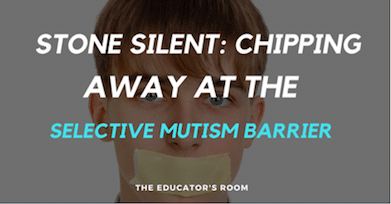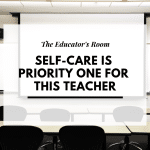Having a student in your classroom with Selective Mutism (S.M.) can be frustrating, confusing, and lead to a feeling of helplessness. You may wonder, “How can I help this child who will not respond to me, talk to me, or to his classmates?” Selective Mutism is a childhood anxiety disorder that may present as oppositional, manipulative, or willful behavior. In truth, the child with S.M. is so anxious that they physically cannot speak.
Some children describe the feeling as having rocks in their throat or as if there are hands grasped around their throats. Others, like my son, can only verbalize to me that he feels scared to talk in school. However, there is hope and there is much that a classroom teacher can do to help these children. Research tells us that treating the S.M. child with a holistic approach where the teacher is part of a treatment team made up of parents, therapists, doctors, and possibly speech-language pathologists is the best approach. The goal is to help the child progress from nonverbal to verbal communication. You, the teacher, play a critical role.
As a teacher, what can you do to support the S.M. child in your classroom?
• If the child has already been diagnosed, they may have an I.E.P., a 504 Plan, or a behavioral treatment plan written by their therapist or psychologist. The parents will share this with you and will most likely include you in the treatment plan, as most encompass a whole child approach that works as a team.
• If you suspect that a severely shy, introverted child may have S.M., communicate with the parents. Children with S.M. will not “outgrow” their shyness. Early intervention and treatment is critical.
• Interact with the S.M. child just as you would any other child. Do not exclude them just because you know they will not reply. Just know that when you ask the child a question, the answer may come in an alternate form such as writing, drawing, gesturing with hands, pointing, mouthing a word, whispering, or nodding the head.
• Do not demand that the child speak. Do not bribe them with rewards or threaten with negative consequences because this can make the anxiety worse.
• Many S.M. children like to sit in the back of the classroom so as not to draw attention to themselves. Typically, they do not like to be in the spotlight and would rather observe from afar than be in the thick of the action.
• Because many S.M. children have control issues, give them choice as much as possible. For example, ask them if they would like to participate in “Show and Tell” and always give the option that they can decline. Or, allow them to “show,” but do require them to speak and “tell.”
• Try not to take the student’s silence personally. For some reason, they have associated school with anxiety and fear. In turn, they transfer this fear to you and to the classroom environment.
• Field trips, lunch, recess, and other unstructured times can be terrifying for S.M. children. Make sure that the whole school community is aware of the child’s disorder and can make the necessary accommodations.
• Hold the child accountable to the behavioral and academic criteria that are expected of all children in your classroom.
• If the child makes progress, praise them for their “brave talking,” but do not go overboard and do not praise them in front of other children. Again, they do not like to draw attention to themselves.
• Trust is paramount. First impressions are everything. At the start, do not make any demands on the child to speak. Try to create a comfortable, nonthreatening environment for the child.
• Many therapists use the process of the desensitizing method to learn new behaviors and coping skills. This is a very slow process with the child taking “baby steps.” For example, my son’s first goal was to nod his head and eventually whisper at the end of the hallway away from where his classroom was. Each week, we tried to make it just a little further down the hallway, closer to his classroom.
• If possible, have the child and parents meet you before school begins. If you can arrange the initial meeting outside of school, this would be ideal. Meeting at a park or even in the child’s home will help to foster a comfortable, low-key atmosphere.
• It may be beneficial to allow the child and the parents to visit the classroom when you are not there, especially prior to the start of school. If the parents can engage the child in playing games or reading to them, they will help to establish a feeling of security within the classroom.
Indeed, Selective Mutism is a very complex disorder. Just like any other anxiety disorder, the child may make great progress and then regress for no apparent reason. Their progress may be inconsistent. Throughout it all, showing unconditional love to these children is paramount. They crave affection, they want to be able to interact with you and their peers, and they desire to be understood and heard. With patience, persistence, and a positive attitude, you, the teacher, can help these children break their silence.






